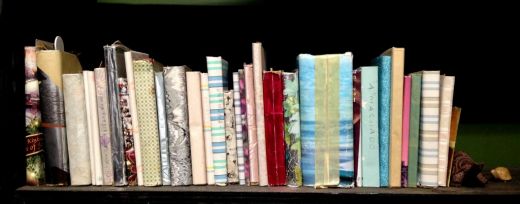The State of the Book: Antonia Wright and Ruben Millares
Kate Peters

State of the Book, Installation view. Courtesy of the Artists and Spinello Projects.
July 18 – September 28, 2013
Spinello Projects
By Kate Peters
Inside, the room is painted dark green, Goodnight Moon with the lights down. Two velvet club chairs nestle around a table and lamp. Books on shelves are punctuated by objects: an amp, a polaroid camera, etc. Set dressing includes botanical and entomological prints of moths or butterflies. Unremarkable enough not to draw attention to where they lean above the bookshelves, the prints make quiet reference to man’s taxonomic drive to arrange and classify. When Linnaeus named the order Lepidoptera, Samuel Johnson was making his Dictionary of the English Language and Diderot the Encyclopédie, a very different time for the book.
Three days after the installation opened on July 13, Mayor Carlos Giménez announced the closure of 22 out of 49 public libraries in Miami-Dade County. The number bandied about next was 14. Now four. Libraries will see reductions in hours and staff; the Main Library downtown scared into the space of two floors instead of three; and 192 of the original 251 projected layoffs are still slated to occur before the new fiscal year. There is no doubt that Wright’s and Millares’s exhibit is timely.
Worry—that books in a gallery would seem like rarified museum specimens going the way of the dodo—is quelled by a space that still feels vital and serviceable. The only thing that can’t be read is an apropos contribution from The Margulies Collection, three Webster’s Dictionaries cocooned in resin by artist Stella Waitzkin in the 1970s. The Bass Museum, MAM and MOCA all contributed catalogues from past exhibitions, and that this element of the past makes such an impression emphasizes the finality of books in contrast to the fluidity of digital updates.
In Christina Pettersson’s shelf on birds, identification books neighbor Marcel Proust’s Swann’s Way and the memoir Flying by the author of Sexual Politics, Kate Millett. While the association may be cheeky, it reminds one of the suggestiveness of language, and enlivens otherwise sleeping metaphors. It invites an observance of juxtapositions elsewhere, whether contrived or accidental, such as the Encyclopedia of Catholic Doctrine leaning against Donna Tartt’s A Secret History, or Every Woman’s Diet Handbook next to The Tiger Woods Way.
Artist Marcos Valella contributes a selection of his grandmother’s books, each of which she jacketed in wrapping paper. While giving me a tour, Ruben Millares seemed touched by this gesture of “protecting the book,” something he is invested in, taking in the discarded books of downsizing libraries and closing bookstores. With the titles hidden, her books become completely personal. Moreover, they are freighted with personal documents. Poesia Universal contains poems torn from newspapers and three drawings in ballpoint pen: two partial-bodied, bespectacled old women, and one adolescent girl slouching. From a biography of José Martí pours a Saint Francis of Assisi prayer card, a postcard from Denver and an article about Jimmy Carter. Dali’s Confesiones Inconfesables houses magazine articles from the time of the artist’s death. Her books and their internal artifacts become diaristic and autobiographical in a way that reminds the viewer that, for those of us who keep our books anyway, they constitute a material trace of intellectual and personal history. Antonia Wright and Ruben Millares seem well aware of it, each offering shelves that outline what they have read in recent years, their interests, and their families. The pleasures of looking through them can feel voyeuristic, like you’re a houseguest left unattended.
From their 2010 work, “Job Creation in a Bad Economy,” it is also clear that they recognize the materiality of books, the way it feels to run into and fall over a wall of them, the way the corner of one can catch you in the hip or between the ribs as you land. All the performances I’ve seen, videos quickly retrieved from the digital ether, are concerned with immediate physical experience: Wright rolling naked down a filthy alley, mixing pigments in her eye or performing tai chi covered in bees; the duo kissing for such an extended period on an escalator—modern marvel to evade physical sensations of exertion—that the viewer’s jaw begins to ache. While I loved being in it, one cannot deny that the reading room is a quiet and nostalgic arena. The stillness will be interrupted by contributor readings throughout the month. Ideally, one would check in on “The State of the Book” at least twice: once to experience the hush, and then again for a reading or the closing performance at the end of September, called “Copyright Infringement,” which one anticipates is the rupture the hush is waiting for.










